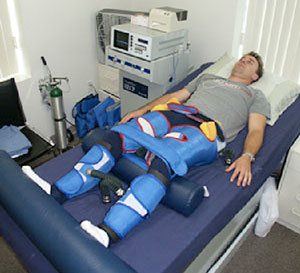ECP
What is ECP? ECP refers to the use of epinephrine or adrenaline to treat acute heart attacks and chest pain by delivering low doses of oxygen to the heart. Enhanced External Counter Pulse (EDCP) is performed after cardiac arrest and is a non-invasive therapy to reduce the frequency and intensity of cardiac attacks. EECP is a highly effective non-pharmacological therapy that delivers oxygen to the heart to reduce blood pressure and increase cardiac output. Treatment is generally given through three pairs of elastic external cuff devices that are placed around either the upper legs lower legs or buttocks.
The majority of patients who require treatment have a decreased cardiac output, increased blood pressure, and mild to moderate coronary artery disease (CAD) with no evidence of hypertrophy (normal-sized heart). There are also some patients with congenital heart disease, a condition where there is an abnormality in the dimensions of the heart at birth. Such patients may need additional treatment for their heart failure with the same therapy as those for ECP.
ECP treatment involves the delivery of extra amounts of blood into the heart via the elasticized skin cannula and inflated cuff. Extra blood is needed to dilate the large arteries, widen the diameter of the heart, and allow more blood to circulate to the limbs. This is achieved by increasing the ventricular wall mass, increasing the left ventricular wall elasticity, and increasing the heart function through a mechanical process called traction. Traction elongates the heart chambers vertically and provides additional blood flow to the heart.
During the therapy, the patient may have to undergo different types of invasive procedures such as angioplasty, sclerotherapy, coronary artery dilation, cardiac telemetry, and coronary artery spasm. In addition, the heart-care specialist may use other methods such as electrical pacing, exercise physiology, heart failure modelling, and ultrasound or magnetic resonance imaging to evaluate the progress of the patient’s heart health. For example, the magnetic imaging will show the extent of the heart disease using magnetic resonance imaging and then send it to the computer for the detailed analysis. ECP technology in many ways are similar to that of cardiac rehabilitation where the heart function is analysed through invasive procedures.
After a certain level of deterioration is noted, the heart failure patient will be given a list of possible treatment options that can include surgery. For the vast majority of patients suffering from ECP, further treatment is not necessary. However, if the patient’s experience further deterioration after undergoing a successful ECP therapy system, they may be required to undergo arthroscopic surgery, cardioplasty, or valve repair. Moreover, if patients require an invasive procedure, they may have to choose between coronary artery dilation and aortic valve repair. The majority of patients who undergo invasive procedures choose the latter, because they are more effective at preventing further damage to the heart.
Furthermore, for those individuals who are not suffering from any major medical conditions but are having the symptoms of ECP such as pain, stiffness, increased heart rate, dizziness, and palpitations, they should still receive therapy even if they are not showing signs of heart disease. This is because they can still receive benefits from an ECP therapy system by utilizing the enhanced external counter pulsation method which aids in the proper oxygenation of the blood in the body. Enhanced external counter pulsation is a non-invasive method of delivering oxygen to the blood stream. It is commonly used to treat patients with mild to moderate cardiomyopathy. This means that the enhanced external counter pulsation technique can help patients undergoing cardiomyopathy recover from heart disease by reducing pain and improving the functioning of the heart muscle.


